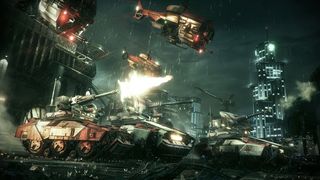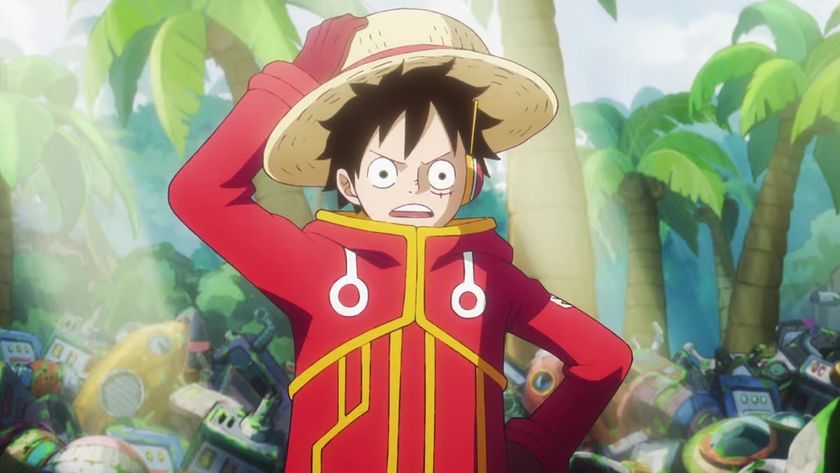Arkham Knight's bold new ideas had me worried. But now I've played it, I'm sold
Although unconnected, there are some strong parallels to be drawn between Rocksteady’s Arkham trilogy and Christopher Nolan’s Dark Knight triptych. Both hit their respective media after years of dismal depictions from other creators. Both inaugural entries changed everything upon release, raising bars and shifting perceptions forever. Both were followed up by second entries that blew the doors off their core concepts, upping the scale, upping the stakes, and adding an exponential increase in Big Serious Drama. It seemed that nothing could go wrong.
But then, in film, we got The Dark Knight Rises, and were punched hard in the face by the tricky reality of completing a satisfying trilogy when your second part is already close to perfect. As great as TDKR is in many ways, it suffers from a major case of ‘Where do we go from here?’ syndrome. Its cast list is bloated, as is its offering of plot threads. Driven by expectations of further escalation, it presents a scenario which stumbles between the epic and the too-epic-to-engage-with. With so many disparate elements to juggle, its tone fluctuates wildly, and it loses the central focus on character that made its predecessors so compelling.

For a long while, I’ve worried about the same problems afflicting the upcoming Batman: Arkham Knight, Rocksteady’s parallel part three. Its structure looks to be ‘Arkham City: Loads More Of Everything Edition’. It has a new villain, created by Rocksteady and stapled into the sprawling narrative aftermath of the last game. It has an overhauled approach to environment, to accommodate the use-anywhere Batmobile, a machine looking to play like a combination of Burnout and Halo. It has ‘dual-play’, a system which brings Batman’s allies into combat and stealth, to assist. It has a whole lot of things that, for a long time, I’ve worried are going to be just too much.
I’m not against change. I’m all for it. One of the things I’ve loved about Rocksteady since Arkham Asylum is the studio’s steadfast refusal to play safe. Batman game? Screw the licensed quickie approach. Let’s go deep on the detail and make a serious, legitimate adaptation that just happens to be a video game. Sequel? Let’s keep the core gameplay mechanics and change everything else. I love Rocksteady for that attitude, and I love Rocksteady for delivering it so cleverly, with so much careful thought and insight. You see I’m all for change and evolution, but only when it’s the right change and evolution, executed with considered intelligence rather than sensationalism or bombast. It’s in that latter respect that I’ve found Arkham Knight problematic of late.
You see, while Rocksteady has been talking of Arkham Knight’s additions in terms of completing the Batman power fantasy, power has never been the be-all and end-all of Gotham’s defender for me, either in the games or in terms of the character as a whole. The wonderful thing about the previous Arkhams is that they’re not supercharged exercises in superhero mook-smashing, but carefully balanced Batman simulators. They’re about putting you directly in the man’s boots, and letting you fully personify him by way of lean gameplay mechanics that emphasise creative strategy in order to appear superhuman, wringing every last tactical advantage out of each situation to make survival look like triumph. In short, they’re about doing what Batman has to do every single night.

But the ability to call in back-up? A Batmobile that turns into a tank? All of that felt like it was pushing things in the wrong direction, taking the emphasis away from the man and his personal skills and abilities, and putting the focus on artificial empowerment, external to himself. It had me worried. It had me fearing another case of TDKR-style bloat. It had me eager and nervous to go hands-on, in equal measure.
And now I have. And you know what? I’m now just really, really excited. Because Rocksteady, those clever, clever bastards, seem to have done what Nolan didn’t quite manage. Based on the current build, which I played last week in LA, Batman: Arkham Knight seems to be a brilliantly pitched example of exactly the considered evolution I was talking about earlier.
Sign up to the 12DOVE Newsletter
Weekly digests, tales from the communities you love, and more
Dual-play combat? Sublime. Rather than diluting Batman’s presence, it’s actually designed with a canny focus on creating an affecting sense of teamwork without ever reducing the player’s sense of agency. As Batman, I step into the fray as usual. I rapidly notice that the scale of the fight is much greater than I expect. Nightwing’s presence has rebalanced the odds, freeing the game to assault me with a goon-count easily matching the epic battles toward the end of Arkham City. The sense of dramatic escalation is fantastic, and instantly imbues Arkham Knight with a drastically increased sense of tension entirely fitting for this climactic chapter. But crucially, I am always in control.

Nightwing covers my back, ensuring that although I have a sense of being overwhelmed, I never am. But he never permanently disables a goon unless I trigger him to do so by way of a co-op takedown. Those, activated with a simple stab of L1, are just stunning. Remember how you felt when you first saw Arkham Asylum’s freeflow combat in action? Remember the sheer, cinematic impossibility of what was unfolding in front of your eyes, in real-time? Get ready to feel that again. As Nightwing, I launch a guy high into the air with a flipping vertical kick. As the battered ne’er-do-well flies, the camera dynamically spins round to catch Batman already leaping in. He grabs the mook by the ankles and powerbombs him into the wall. The camera seamlessly pans back to the normal combat view, and we continue.
Sorry, I should clarify that ‘as Nightwing’ bit. You see the reason I am always in control is that I’m actually playing as both characters. During co-op takedowns, the other vigilante effectively tags in, and control transfers in the aftermath. Far from being confusing, it adds a marvelous energy and dramatic pacing to the fights, and also a fair bit of excellent, ambient narrative texture.
Where the Bat-Family have previously only appeared in the games as cameos, isolated acknowledgements with no real, integrated meaning, the sense of teamwork, the sense of them existing as a real, tangible entity, is now undeniable. Having controlled them as a single unit, the sense of their presence remains long after Nightwing takes his leave. Again, it’s a great way of creating a sense of escalation without screwing with the core player experience. I might be stalking the rooftops solo later on, but I know that at times this desperate, a Batman is never alone.

‘All well and good’, you might ponder, ‘but how the hell can tank combat deliver a similarly intimate experience?’ Again, I refer you to my point about Rocksteady being clever bastards. Because while there’s no on-screen humanity to temper the scale of mechanised combat, everything about the experience of Arkham Knight’s vehicular blasting is designed to make it feel like you’re controlling Batman, not his vehicle. Maintaining the rhythmic, musical feel of the series’ hand-to-hand fighting, it’s much more DDR than Gears of War.
Trapped in the middle of a small fleet of tanks (important positioning, as it immediately evokes freeflow’s sense of being outnumbered in the middle of the fray; there’s no long-range target practice here), incoming shots are highlighted by a pre-emptive green laser trail running along the ground. When they turn red, usually after a couple of seconds, I’ve been locked onto, and will probably get hit. Thing is, those lasers aren’t a sporadic, casual threat. They’re constant, a pulsing, illuminated dancefloor, dictating the cadence and rhythm of the battle and my movements within it. They cross and stack upon each other, cutting off parts of the ground, and opening up new areas on a second by second basis They’re the heavy ordnance equivalent of the blue counter indicators in the hand-to-hand fights.

Aiming and shooting are secondary considerations. It’s really about how I move, how I dodge, how I shimmy, moment-to-moment, to skip past damage and find new attack windows. I’m not a lumbering piece of heavy duty hardware. I’m the nimble, evasive, strategically aware man inside the hardware. I’m vulnerable. I’m under constant threat. But I have the lean moves and the creative tactics to make survival look like triumph. It’s not tank combat. It’s Batman fighting from inside a tank.
So I’m relieved, and excited, and only now entirely hopeful, after finally playing Arkham Knight. Is it going to be a different Batman game to those we’ve played before? Yes, but then so has been every other Rocksteady Batman game. And that’s never been a bad thing. The important thing is that while the series’ scope is certainly going to change, it looks like its focus is going to remain the same. And that focus is the Batman himself, exactly as it should always be.












